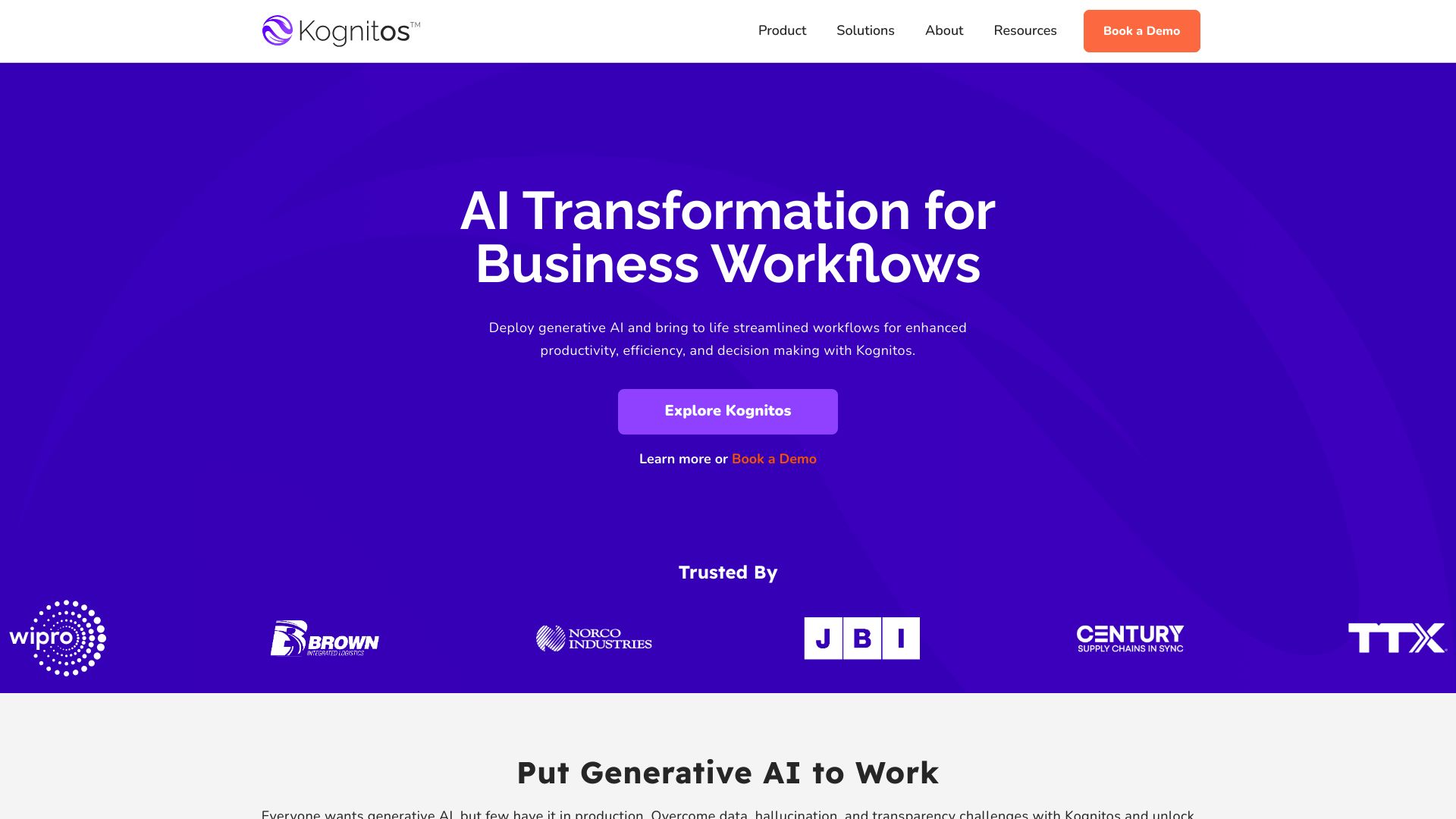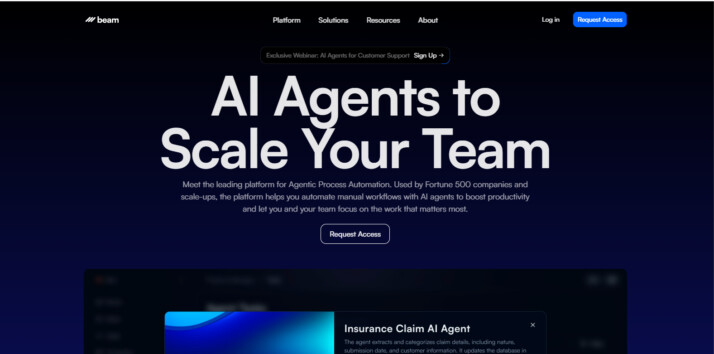Kognitos vs. Beam AI: Comparing AI-Powered Automation Platforms
AI-powered automation revolutionizes business operations, but choosing the right platform can be daunting. This comparison explores Kognitos vs. Beam AI, and SmythOS, three leading solutions transforming how organizations streamline processes and leverage artificial intelligence. We’ll examine their unique approaches to natural language processing, visual development tools, and deployment options. By analyzing key features, integration capabilities, and user experiences, this guide equips developers, business leaders, and AI enthusiasts with the insights needed to select the optimal platform for their automation needs. Discover how these innovative tools are reshaping workflow efficiency, enhancing productivity, and unlocking new possibilities in AI-driven business transformation.
Kognitos Overview
Kognitos transforms business automation through its innovative natural language processing platform. This AI-powered solution enables users to create and manage complex workflows using plain English, eliminating the need for traditional coding skills.


The platform excels in document processing, data extraction, and system integration, making it ideal for enterprises seeking to streamline operations across various departments. Kognitos leverages generative AI and large language models to interpret user instructions, handle exceptions, and adapt to changing business needs.
Kognitos leverages generative AI and large language models to interpret user instructions, handle exceptions, and adapt to changing business needs.
Unlike traditional robotic process automation (RPA) tools, Kognitos operates entirely through a browser interface, reducing the complexity of bot management. This cloud-based approach ensures scalability and accessibility, allowing businesses to automate processes ranging from simple data entry tasks to complex, multi-step workflows.
Kognitos shines in its ability to learn and improve over time. The system’s AI agents engage in natural dialogue with users to clarify instructions and handle exceptions, continuously enhancing their performance. This adaptability proves particularly valuable in dynamic business environments where processes frequently evolve.
While Kognitos offers powerful automation capabilities, it may require a learning curve for users accustomed to visual programming interfaces. The platform’s focus on natural language interactions, while innovative, might initially feel unfamiliar to those used to traditional coding or drag-and-drop builders. However, this approach ultimately democratizes automation, making it accessible to a broader range of business users.
Beam AI Overview
Beam AI develops generative AI agents to automate repetitive tasks for organizations. Their Agentic Process Automations (APAs) handle data extraction, customer inquiries, compliance tasks, and order processing more efficiently than humans. These AI agents continuously learn and adapt, improving precision over time.
Beam AI’s platform focuses on natural language automation rather than visual interfaces. Users write automation processes in plain English, eliminating traditional coding requirements. The AI agents operate autonomously to handle tasks and exceptions, with humans involved for oversight and process improvement. This approach aims to boost productivity while allowing teams to focus on higher-value work.


Beam AI’s platform focuses on natural language automation rather than visual interfaces. Users write automation processes in plain English, eliminating traditional coding requirements.
Key features include integration with existing systems, detailed audit logs, and support for processing various document types like PDFs and Word files. Beam AI emphasizes scalability, security, and enterprise-grade capabilities to meet the needs of large organizations. However, the platform lacks some advanced features like multimodal inputs, visual builders, and direct integrations with services like Zapier.
For developers and technical teams, Beam AI offers API integrations and backend automation similar to robotic process automation. Business users benefit from the no-code natural language interface for creating automations. While powerful for certain use cases, Beam AI may have limitations for users seeking more visual development tools or specialized AI model customization options.
Feature Comparison
Kognitos and Beam AI offer natural language-based automation platforms, but lack visual builders and some advanced AI capabilities that SmythOS provides. While both focus on using plain English to create automations, SmythOS delivers a more comprehensive suite of AI agent development tools.
SmythOS stands out with its drag-and-drop visual interface for building complex AI workflows without extensive coding. This visual approach, absent in Kognitos and Beam AI, makes advanced AI development more accessible. SmythOS also excels in multi-agent collaboration, allowing teams of AI agents to work together on complex tasks — a capability not explicitly offered by Kognitos or Beam AI.
In terms of security and deployment, SmythOS provides more robust options. It offers constrained alignment features to ensure AI behavior aligns with organizational goals, and supports diverse deployment options including as APIs, webhooks, site chats, and scheduled agents. Kognitos and Beam AI, while integrating with existing systems, do not specify such a wide range of deployment capabilities. SmythOS’s hosted vector database and support for various data sources like sitemaps and YouTube transcripts further differentiate it from Kognitos and Beam AI, which focus more on document processing and traditional data sources.
Feature Comparison Table
| Kognitos | Beam AI | SmythOS | |
|---|---|---|---|
| CORE FEATURES | |||
| Visual Builder | ❌ | ❌ | ✅ |
| No-Code Options | ✅ | ❌ | ✅ |
| Debug Tools | ✅ | ❌ | ✅ |
| Multimodal | ✅ | ❌ | ✅ |
| SECURITY | |||
| Constrained Alignment | ❌ | ✅ | ✅ |
| IP Control | ❌ | ✅ | ✅ |
| COMPONENTS | |||
| Zapier APIs | ❌ | ✅ | ✅ |
| Data Lakes | ❌ | ❌ | ✅ |
| DEPLOYMENT OPTIONS (EMBODIMENTS) | |||
| Deploy as Webhook | ❌ | ✅ | ✅ |
| Deploy as Site Chat | ❌ | ✅ | ✅ |
| Deploy as GPT | ❌ | ✅ | ✅ |
| DATA LAKE SUPPORT | |||
| Hosted Vector Database | ❌ | ❌ | ✅ |
| Sitemap Crawler | ❌ | ❌ | ✅ |
| YouTube Transcript Crawler | ❌ | ❌ | ✅ |
| URL Crawler | ❌ | ❌ | ✅ |
Best Alternative to Kognitos and Beam AI
SmythOS stands out as the superior alternative to Kognitos and Beam AI, offering a comprehensive AI automation platform that surpasses the capabilities of its competitors. We’ve designed SmythOS to empower users with a versatile and user-friendly system for creating and deploying AI agents across various applications.
Our platform’s visual builder sets it apart from Kognitos and Beam AI. While they focus on natural language inputs, SmythOS provides an intuitive drag-and-drop interface that makes complex AI workflow creation accessible to users of all skill levels. This visual approach significantly reduces development time and allows for rapid prototyping and iteration.
SmythOS provides an intuitive drag-and-drop interface that makes complex AI workflow creation accessible to users of all skill levels.
SmythOS excels in multi-agent collaboration, a feature not explicitly offered by Kognitos or Beam AI. Our platform enables teams of AI agents to work together on complex tasks, mirroring human team dynamics and enhancing overall productivity. This capability is crucial for businesses looking to automate intricate processes that require coordinated efforts.
In terms of deployment options, SmythOS offers unparalleled flexibility. We support a wide range of deployment methods, including APIs, webhooks, site chats, scheduled agents, and even integration with platforms like GPT. This versatility ensures that our AI agents can be seamlessly integrated into existing systems and workflows, adapting to the specific needs of any organization.
Unlike Kognitos and Beam AI, SmythOS provides advanced data handling capabilities, including a hosted vector database and support for diverse data sources such as sitemaps, YouTube transcripts, and various file formats. This comprehensive approach to data management enables our users to create more sophisticated and context-aware AI agents, capable of processing and analyzing information from a wide array of sources.
Conclusion
Kognitos and Beam AI offer innovative natural language-based automation solutions, but SmythOS emerges as the superior choice for AI agent development and deployment. While Kognitos and Beam AI excel in document processing and specific automation tasks, SmythOS provides a more comprehensive and versatile platform for creating sophisticated AI workflows.
SmythOS’s visual builder sets it apart, enabling users to construct complex AI systems without extensive coding knowledge. This feature, combined with its support for multi-agent collaboration and diverse deployment options, makes SmythOS exceptionally adaptable to various business needs. The platform’s robust security measures, including constrained alignment and data encryption, ensure that AI behavior aligns with organizational goals while maintaining data integrity.
For developers and technical teams seeking advanced AI capabilities, SmythOS offers unparalleled flexibility with its extensive API integrations and support for various AI models. Business leaders will appreciate SmythOS’s scalability and enterprise-grade features, which facilitate seamless integration into existing systems. Non-technical users benefit from SmythOS’s intuitive interface and pre-built templates, democratizing AI development across organizations.
To experience the full potential of AI automation and agent development, explore SmythOS’s diverse range of AI-powered agent templates. These templates cover multiple business categories and offer a quick start to revolutionizing your workflow. For those ready to take the next step, create a free SmythOS account and start building AI agents with no time limit – discover how SmythOS can transform your approach to AI integration and automation today.
Last updated:
Disclaimer: The information presented in this article is for general informational purposes only and is provided as is. While we strive to keep the content up-to-date and accurate, we make no representations or warranties of any kind, express or implied, about the completeness, accuracy, reliability, suitability, or availability of the information contained in this article.
Any reliance you place on such information is strictly at your own risk. We reserve the right to make additions, deletions, or modifications to the contents of this article at any time without prior notice.
In no event will we be liable for any loss or damage including without limitation, indirect or consequential loss or damage, or any loss or damage whatsoever arising from loss of data, profits, or any other loss not specified herein arising out of, or in connection with, the use of this article.
Despite our best efforts, this article may contain oversights, errors, or omissions. If you notice any inaccuracies or have concerns about the content, please report them through our content feedback form. Your input helps us maintain the quality and reliability of our information.
